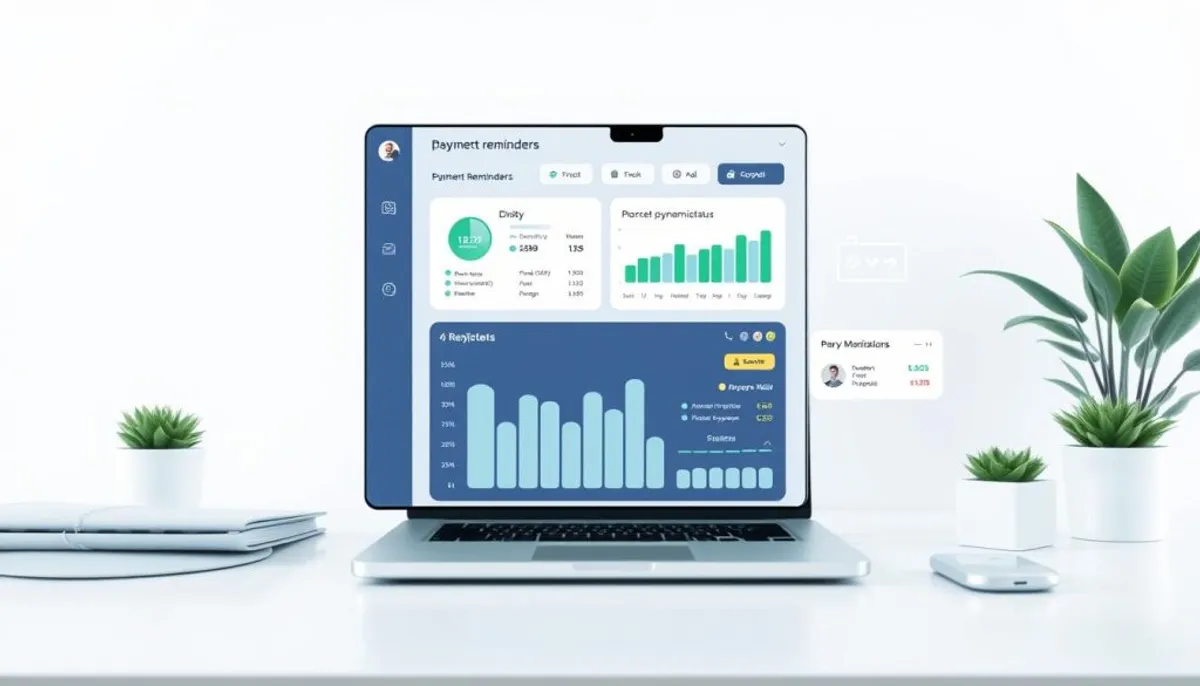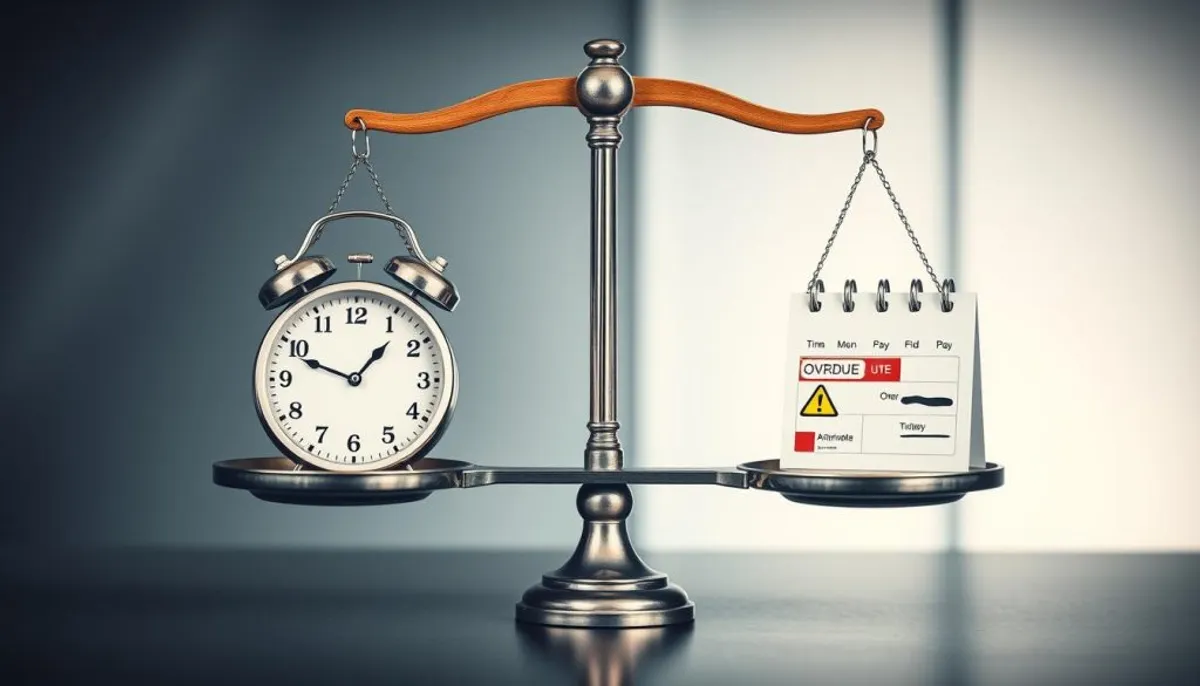Late payments can severely disrupt a business’s cash flow. With 87% of companies facing invoices paid after the due date, it’s evident that overdue invoices are a common challenge. Sending friendly payment reminders is crucial for maintaining smooth transactions and building strong client relationships.
Effective collections begin with timely, polite reminders for overdue invoices. These emails act as gentle reminders, encouraging clients to settle their outstanding balances. By adopting a strategic approach to managing accounts receivable, businesses can significantly reduce payment delays and enhance their financial health.

Timing is essential when crafting payment reminders. A few days before the invoice due date, the first email should serve as a friendly reminder. For clients with a history of tardiness, earlier reminders may be necessary. It’s vital to consider each client’s preferred communication method to ensure your message is received and acted upon promptly.
Key Takeaways
- Start with pre-due date reminders about a week before payment is due
- Send polite overdue invoice reminders within 1-3 days of the due date
- Follow up with early reminders 5-7 days after the invoice becomes overdue
- Use more assertive reminders for invoices 14-21 days past due
- Send final reminders 30-45 days after the due date, indicating potential further action
- Always balance firmness with politeness to maintain good client relationships
- Confirm receipt of payment promptly to acknowledge the resolved matter
Understanding the Late Payment Crisis in Business
Late payments are a significant challenge for businesses globally, affecting their cash flow and financial health. The crisis is severe, with 87% of businesses experiencing delayed invoice payments. This issue impacts companies of all sizes, from small enterprises to large corporations.
Impact on Business Cash Flow
Late payments severely disrupt cash flow, hindering growth and operational efficiency. Companies waste 56.4 million hours annually on chasing overdue payments. This time could be better spent on core business activities and expansion efforts. The strain on cash flow can lead to serious consequences, including potential insolvency.
Global Statistics on Late Payments
The late payment crisis is a global phenomenon, with troubling statistics across various regions:
- Corporate insolvencies doubled during 2022
- 40% of small and medium businesses reported worsening late payments
- One-third of small businesses still face delayed payments
- Large food and tobacco firms paid 70% of supplier invoices late in the first half of 2022
Common Causes of Payment Delays
Several factors contribute to payment delays:
| Cause | Description |
|---|---|
| Complex Approval Processes | Invoices often pass through multiple departments before reaching the payment authority |
| Limited Payment Options | Lack of diverse payment methods can slow down transactions |
| Ineffective Follow-up | 30% of SMBs fail to consistently follow up on unpaid invoices |
| Extended Payment Terms | Some sectors impose long payment terms, up to 90 days or more |
Addressing these causes through proactive measures and clear communication can help businesses combat the late payment crisis and maintain healthy cash flow.
The Art of Writing Professional Payment Reminders
Creating professional payment reminders requires a blend of assertiveness and respect. Effective communication in invoicing is crucial for maintaining positive client relationships while ensuring timely payments. Let’s examine the key components of crafting impactful reminders.
A professional payment reminder email begins with a friendly greeting and clearly states its purpose. Include detailed invoice information and provide clear payment instructions. The tone should be professional yet courteous, highlighting the urgency of prompt payment without damaging client relationships.
Consider this timeline for sending reminders:
- Immediately after due date: Send a gentle nudge
- One week after: Follow up with increased urgency
- Two weeks after: Adopt a firmer tone, offer assistance
- Beyond two weeks: Take a more direct approach
Customize your reminder timeline using accounts receivable automation software like InvoiceSherpa. This tool enables you to set automatic reminders tailored to your business needs and client relationships. It streamlines the payment process and reduces administrative burden.
| Element | Best Practice |
|---|---|
| Subject Line | Clear and concise to improve open rates |
| Introduction | Personalized and polite to increase response chances |
| Payment Options | List all available methods with detailed instructions |
| Invoice | Attach to the email for easy access |
| Frequency | Send in a series to improve response rates |
By mastering the art of writing professional payment reminders, you can enhance cash flow, maintain strong client relationships, and ensure the financial health of your business.
Essential Elements of Email For Past Due Invoices
Creating effective emails for past due invoices is critical for sustaining cash flow. Given that up to half of US business invoices are overdue, mastering the art of invoice email elements and professional communication is imperative.
Subject Line Best Practices
Your subject line is the initial point of contact for clients. It should include the invoice number and due date. This strategy captures attention and establishes the email’s tone.
Invoice Information Requirements
Clear, concise invoice details are essential. Include the invoice number, amount due, and due date in the email body. This clarity facilitates understanding and prompts clients to take action.
Payment Terms and Instructions
Offer clear payment instructions to enhance the likelihood of timely payment. Specify various payment options such as online portals, checks, or wire transfers. This flexibility can expedite resolution.
Professional Tone and Language
Balance friendliness with firmness in your communication. A personalized greeting can foster a connection, making the email feel less automated. Maintain a professional tone that conveys urgency without being aggressive.
| Email Element | Purpose | Impact |
|---|---|---|
| Subject Line | Grab attention | Increases open rates |
| Invoice Details | Provide clarity | Improves understanding |
| Payment Instructions | Facilitate action | Speeds up payment process |
| Professional Tone | Maintain relationships | Encourages positive response |
By integrating these essential elements, you can craft effective past due invoice emails. These emails encourage prompt payment while preserving professional relationships with clients.
Strategic Timing of Payment Reminder Emails
Timing is everything when it comes to payment reminders. A well-thought-out schedule can greatly enhance the success of your invoice follow-up efforts. Understanding the various stages of an overdue notice timeline is essential.
Pre-Due Date Notifications
It’s wise to send a gentle reminder 5-7 days before the payment is due. This early alert allows clients to prepare for the upcoming payment, potentially avoiding late fees.
First Overdue Notice Timeline
On the due date, a prompt email serves as a gentle reminder. If payment is still outstanding, a second reminder 2-7 days later is necessary. This strategy keeps the invoice at the forefront of clients’ minds.
Follow-up Schedule Guidelines
For invoices that are two weeks past due, the communication must become more urgent. Here’s a suggested follow-up schedule:
| Timeframe | Action |
|---|---|
| 5-7 days before due date | Friendly reminder |
| On due date | Early morning email |
| 2-7 days past due | First overdue notice |
| 14 days past due | Urgent reminder |
| 30 days past due | Final notice |
Always express gratitude when payment is received. This gesture strengthens client relationships and encourages timely payments in the future.
Maintaining Client Relationships During Collections
The art of balancing professional collections with the preservation of client relationships is intricate. Despite the reality that 45% of businesses encounter late payments, the maintenance of these connections is paramount. The essence of this balance is found in payment communication that is both assertive and amicable.
In addressing overdue invoices, it is imperative to maintain a positive demeanor. Acknowledge the significance of your client’s business while explicitly communicating your payment requirements. This strategy cultivates mutual understanding and cooperation, even in the face of adversity.
When feasible, extend flexibility in payment options. This gesture signifies your dedication to discovering mutually beneficial solutions. Providing clear, straightforward payment instructions can further facilitate the process and avert potential miscommunications.
| Strategy | Impact on Client Relationships | Effect on Collections |
|---|---|---|
| Friendly reminders | Maintains positive rapport | Encourages prompt payment |
| Flexible payment options | Shows understanding | Increases likelihood of payment |
| Clear communication | Builds trust | Reduces payment delays |
It is noteworthy that a mere 5% increase in customer retention can significantly enhance profits by 25-35%. By achieving a harmonious equilibrium between collections and client service, you not only recover payments but also foster enduring business relationships.
Automated Payment Reminder Solutions with ti3
Managing overdue accounts can be a significant challenge for businesses. ti3 offers a comprehensive invoice management software solution to address this issue. This platform simplifies the collection process, enabling companies to manage late payments more efficiently.
Features and Benefits
ti3 provides a range of features to streamline invoice management:
- Customizable reminder schedules
- Integrated payment options
- Detailed analytics
- SMS and email reminders
- Real-time tracking of settlement activities
These automated payment reminders have shown to be highly effective. Businesses utilizing ti3 have seen a 20% rise in on-time payments within 30 days post-due date.

Implementation Process
Implementing ti3 is remarkably simple. Its user-friendly interface facilitates seamless integration with tools like Excel. Creditors can efficiently manage up to 1,000 overdue accounts at once, making it perfect for businesses with numerous debtors.
Cost-Effective Alternative
ti3 presents a cost-effective alternative to traditional collection agencies. Creditors only pay 49c to 99c per invoice, while debtors benefit from free service. This pricing structure appeals to businesses in Florida and Texas aiming to enhance their cash flow without financial strain.
| Feature | Benefit |
|---|---|
| Automated reminders | 20% increase in on-time payments |
| Customizable payment plans | Improved debtor engagement |
| Real-time tracking | Enhanced transparency |
| Low cost per invoice | Affordable for businesses of all sizes |
Escalation Strategies for Persistent Non-Payment
Dealing with persistent non-payment can significantly drain business resources. Small business owners often spend 14 hours weekly on client payment chasing. A structured non-payment escalation approach is vital to address this issue.
Progressive Communication Approach
Begin with friendly reminders and gradually escalate the urgency. Implementing a five-step strategy, including email templates, can effectively manage past due invoices. Businesses employing automated invoice reminders see payments 5 days faster on average.
Legal Considerations
If initial reminders are unsuccessful, legal collection strategies should be considered. This may involve sending formal overdue notices, imposing late fees, and taking legal action. Late fees are typically flat rates or percentages of the amount owed.
Documentation Requirements
Proper payment documentation is essential for any legal proceedings. Maintain detailed records of all invoices, payment reminders, and client communications. This comprehensive approach supports your case if legal action is necessary.
| Escalation Step | Action | Timing |
|---|---|---|
| Initial Reminder | Friendly email | 1 day after due date |
| Follow-up | Phone call | 7 days after due date |
| Final Notice | Formal letter | 14 days after due date |
| Legal Warning | Legal notice | 30 days after due date |
| Legal Action | Court proceedings | 60 days after due date |
Customizable Payment Reminder Templates
Enhance your collection process with customizable payment reminder templates. These tools are essential for managing cash flow effectively. Given that over half of B2B invoices in the US are overdue, a robust follow-up system is critical.
Payment reminder templates are adaptable for various situations. They can be used for pre-due date alerts, day-of reminders, and overdue notice stages. Customize each template to reflect your brand’s voice and specific payment terms.
When creating invoice email samples, include key details:
- Invoice numbers
- Due dates
- Payment amounts
- Easy payment instructions
Customize reminders for different timelines. Send an initial reminder two weeks before the due date, a follow-up a week before, and a final notice on the due date. For overdue invoices, consider weekly reminders to prompt payment.
Regularly review and update your templates based on their effectiveness and client feedback. This ensures your payment reminder strategy remains relevant and impactful.
Preventing Late Payments Through Proactive Measures
Late payment prevention hinges on clear communication and strategic planning. Businesses can effectively reduce overdue invoices and preserve cash flow through proactive steps. This approach lays the groundwork for a more stable financial environment.
Clear Payment Terms
Clear payment terms are essential for preventing late payments. Include specific payment expectations in contracts and invoices. This clarity ensures clients understand their responsibilities, minimizing the risk of payment delays.
Early Warning Systems
Early warning systems are vital for identifying potential payment issues. Sending reminders 5 days before due dates can prompt timely payments. Regular follow-ups every 10-14 days for overdue invoices keep clients aware of their obligations.
Client Education Strategies
Educating clients on payment processes is crucial for preventing late payments. Highlight the significance of timely payments and the consequences of delays. Offering incentives, such as early payment discounts, can motivate clients to settle payments promptly.

| Proactive Measure | Impact |
|---|---|
| Clear payment terms in contracts | Protects business financial interests |
| Pre-due date reminders | Improves timely payment rates |
| Client education on payment importance | Reduces misunderstandings and delays |
| Early payment incentives | Encourages prompt payments |
By adopting these proactive strategies, businesses can foster a culture of timely payments. This reduces the necessity for extensive collection efforts and enhances client relationships.
Measuring Collection Success and Analytics
Optimizing your accounts receivable process requires tracking collection analytics. Focusing on key payment success metrics enables businesses to enhance their cash flow. Let’s examine crucial accounts receivable KPIs for measuring collection efforts’ effectiveness.
Days Sales Outstanding (DSO) is a foundational metric in collection analytics. It reveals the time elapsed between sales and payment collection. The formula is straightforward: (Accounts Receivable ÷ Total Net Credit Sales) × Number of Days in Period. A DSO below 45 days is generally considered optimal, though this can vary by industry.
The Cash Effectiveness Index (CEI) is another pivotal KPI. It measures the ratio of cash collected to total outstanding receivables, expressed as a percentage. A higher CEI signifies more efficient collection practices.
| Metric | Formula | Interpretation |
|---|---|---|
| AR Turnover Ratio | Net Credit Sales ÷ Average Accounts Receivable | Higher ratio indicates quicker collections |
| Average Collection Period | 365 ÷ Accounts Receivable Turnover Ratio | Lower number of days is better |
| Bad Debt Loss Percentage | (Total Bad Debt Write-offs ÷ Total Credit Sales) × 100 | Lower percentage is preferable |
Regularly reviewing these metrics helps identify trends and assess the effectiveness of different reminder strategies. By leveraging collection analytics, businesses can make data-driven decisions to streamline their accounts receivable process and improve overall financial health.
Conclusion
Effective invoice management is vital for maintaining a healthy cash flow and fostering strong client relationships. Implementing strategic reminder schedules and utilizing automated solutions like ti3 can significantly mitigate the effects of late payments. The statistics are stark: with 1 in 10 invoices not paid on time, and late payments costing global businesses over $3 trillion, timely payments have never been more critical.
Businesses must prioritize clear communication, offer flexible payment options, and take proactive steps. Sending well-crafted reminder emails can boost payment chances, notably when sent shortly after the due date. It’s crucial to act swiftly, as the likelihood of payment drops dramatically at 60 days past due.
Maintaining client relationships is paramount during the collection process. Offering incentives for early payments, providing multiple contact points, and involving account managers when needed can help preserve valuable partnerships. A balanced approach, combining professionalism, persistence, and technology, is essential for successful invoice management and sustained business growth.
RelatedRelated articles



